Range, transposition, and clefs
In this guide...
Key terms:
Subscription required!
To view the complete study guide, you will need a valid subscription. Why not subscribe now?
Already have a subscription? Make sure you login first!
Introduction
A good knowledge of instruments, their families, and their capabilities is essential for music theory, in particular the ranges of instruments and any transposition involved.
Clefs
You have already, or will shortly, have learned about the four clefs used today in music: soprano, alto, tenor, and bass clefs.
Most instruments use just one of these clefs, but there are some that use two or even three clefs. It is important to know which instrument uses which clef, especially when you come to write out music for that instrument.
Some of these clefs can be surprising; it is not always the case that a high-pitched instrument uses the treble clef, for example, or that a low-pitched instrument uses the bass clef.
This is sometimes the case because many instruments are transposing instruments, and read notes that sound much lower than written, requiring the use of a different clef. For example, the bass clarinet reads notes in the treble clef, but these notes sound more than an octave lower.
In some other cases, in particular the alto clef as used by the viola and alto trombone (neither of which are transposing instruments), it is more practical to use the alto clef than the treble or bass clef, which would require the use of many ledger lines.
Grand staff
Some instruments - those which span the entire (or nearly the entire) range of pitch - use the grand staff, with a treble clef on one stave and a bass clef on the other stave.
These are mainly the keyboard instruments - but the harp, also, uses a grand staff.
Range
Along with clef, it is also important to know the range of the instruments that you write for. For more advanced orchestration and composition, it is furthermore important to study how the sound of each instrument changes across its range.
The ranges of each of the common instruments is given in the tables below.
Remember that these ranges are what can be expected of a professional performer in the standard orchestral repertoire, and that the range of an amateur or student performer could be much less.
In particular, the upper ranges may not be available to all performers. Therefore, try to confine your writing to the lower-to-middle range of an instrument - a useful rule-of-thumb is to use only the bottom two octaves of the range, or if you can't remember the range, then try to use only notes that are within (or at most, one ledger line outside) the span of the stave, assuming you are given the instrument's clef.
Strings
The table below lists the instruments in the string family, the clefs they normally use, and the range playable by a professional player in an orchestral / ensemble context. The other clefs listed for some instruments are used when the music is too high or low to display practically on the instrument's main clef.
| Instrument | Main clef | Other clefs | Range | |
|---|---|---|---|---|
| The orchestral string family: | ||||
| Violin | treble | 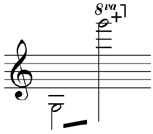 | ||
| Viola | alto | treble |  | |
| Cello (Violoncello) | bass | treble, tenor | 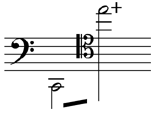 | |
| Double bass (Contrabass) | bass | 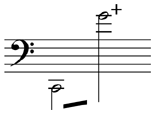 (sounds one octave lower) | ||
| Other string instruments: | ||||
| Harp | treble+bass (grand staff) | 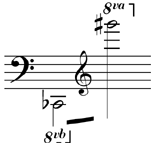 | ||
| guitar | treble | 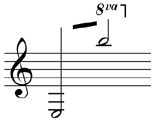 (sounds one octave lower) | ||
Woodwind
The table below lists the instruments in the woodwind family in descending order of pitch, the clefs they normally use, and the range playable by a professional player in an orchestral context.
| Instrument | Doublings | Main clef | Other clefs | Range |
|---|---|---|---|---|
| Flute | Piccolo (higher), alto flute (lower) | treble | 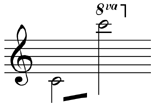 | |
| Oboe | Cor anglais (lower) | treble | 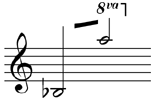 | |
| Clarinet | Bass clarinet (lower) | treble | 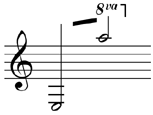 | |
| Bassoon | Double bassoon or contrabassoon (lower) | bass clef | tenor clef | 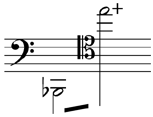 |
Brass
The table below lists the instruments in the brass family in descending order of pitch, the clefs they normally use, and the range playable by a professional player in an orchestral context. Only the orchestral brass instruments and the clefs they normally use are shown. A greater variety of brass instruments is used in wind and brass bands, and these ensembles traditionally use a different clef system in which every instrument plays in the treble clef, transposing accordingly.
| Instrument | Main clef | Other clefs | Range | |
|---|---|---|---|---|
| Trumpet | treble | 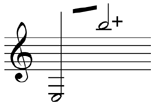 (written a tone higher - transposes in B flat) | ||
| French horn | treble |  (written a perfect fifth higher - transposes in F) | ||
| Trombone | bass | alto, tenor | 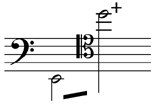 | |
| Tuba | bass | 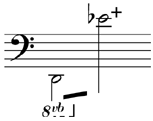 | ||
| Note on ranges:All brass instruments have access to certain lower notes beyond the standard range by means of "pedal" tones. | ||||
Why transpose?
There are several reasons why some instruments are transposing instruments:
- The pitch produced by the instrument might be too high or too low to easily fit on a stave using a standard treble or bass clef. In these cases, music is typically written an octave above or below the actual sounding pitches. For example, the piccolo sounds an octave higher than written, so if the music was written at the actual sounding pitch, the player would have to read many ledger lines above the stave, which could easily become confusing and illegible. Likewise, music for the double bass is written one octave higher than it sounds when played.
- Some instruments that are organised by family all use the same fingering, but sound at different pitches. For example, the saxophones all use the same fingering, and music written for the saxophone is all transposed so that a C written for an alto saxophone, for example, will use the same fingering as a C written for a tenor saxophone, although the notes will sound at different pitches (E flat for the alto saxophone and B flat for the tenor saxophone, in this example). The advantage of this system is that a saxophone player can play any instrument in the family of saxophones and use the same fingering.
- The French horn is a special case. Historically, the horn did not have keys or valves, and so the player would add or remove lengths of the instrument's tubing (known as "crooks") in order to obtain different sets of pitches based on the overtones of different fundamental tones. The notes that sounded would therefore depend on which crook was being used, and music was written as if the fundamental tone was C. Today, horns have keys, and so crooks are not required. Therefore, when horn players play older music on modern instruments, they have to transpose at sight if a crook is called for.
- In addition to instruments that transpose, you might also need to transpose a piece of music to make it higher or lower to suit a different instrument or voice. It is quite common to transpose vocal music in order to make the music fit a different singer's range.
Transposing instruments
An instrument that transposes by a tone are described as being "in B flat" - that is, a C sounds as a B flat. Transposing instruments are usually "in A", "in B flat", "in E flat", or "in F"; instruments that do not transpose may be described as being "in C". Therefore the rule is that an instrument "in X" will sound "X" when they play a C. The interval of transposition when going from concert to transposed pitch is the interval between "X" and the C above; and the interval of transposition when going from transposed pitch to concert pitch is the interval between C and the "X" below.
Music may be written at transposed pitch or at concert pitch; the note sounding C played by an instrument "in F" would be written as G at transposed pitch, and would be written as C at concert pitch.
The following table shows the main transposing instruments, and the interval they are transposed by:
| Strings | |||||
|---|---|---|---|---|---|
| In... | Interval of transposition | Written C... | ...sounds as | Sounding C... | ...written as |
| Double bass | |||||
| in C | octave |  |  |  |  |
| Woodwind | |||||
| In... | Interval of transposition | Written C... | ...sounds as | Sounding C... | ...written as |
| Piccolo | |||||
| in C | octave |  |  |  |  |
| Clarinets | |||||
| in B flat | tone |  |  |  |  |
| in E flat | major 6th |  |  |  |  |
| in A | minor 3rd |  |  |  |  |
| Soprano saxophone | |||||
| in B flat | tone |  |  |  |  |
| Alto saxophone | |||||
| in E flat | major 6th |  |  |  |  |
| Tenor saxophone | |||||
| in B flat | octave + tone |  |  |  |  |
| Baritone saxophone | |||||
| in E flat | octave + major 6th |  |  |  |  |
| Contrabasson | |||||
| in C | octave |  |  |  |  |
| Brass | |||||
| In... | Interval of transposition | Written C... | ...sounds as | Sounding C... | ...written as |
| French horn | |||||
| in F | fifth |  |  |  |  |
| Trumpet | |||||
| in B flat | tone |  |  |  |  |
Read more...
With a subscription to Clements Theory you'll be able to read this and dozens of other study guides, along with thousands of practice questions and more! Why not subscribe now?
Revision
Are you sure you've understood everything in this study guide? Why not try the following practice questions, just to be sure!